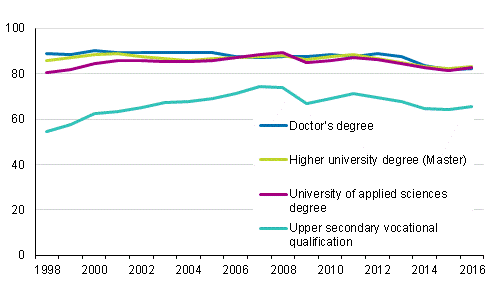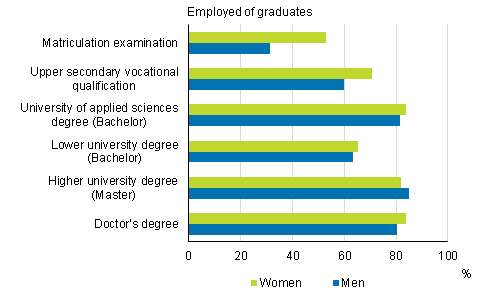Published: 25 January 2018
Recent graduates found employment more easily than in the previous year
According to Statistics Finland's Education Statistics, recent graduates found employment more easily in 2016 than one year earlier. Employment turned to a slight growth after four years of weakening. One year after graduation, 65 per cent of those with qualifications from upper secondary vocational education and 83 per cent of those with university of applied sciences degrees and higher university degrees were employed. Eighty-two per cent of those with doctorate degrees were employed.
Employment of graduates one year after graduation 1998–2016, %

Employment among recent graduates is measured one year after their graduation. Sixty-six per cent of all graduates were working one year after graduation, which is one percentage point more than in the year before. In total, 51 per cent of graduates were working full-time and 15 per cent were working besides studies in 2016. The proportion of the unemployed was 13 per cent.
Recently graduated women found employment more often than men
In 2016, recently graduated women had found employment 10 percentage points more than men. In all, 71 per cent of all recently graduated women and 61 per cent of men were working. Sixty-five per cent of those with qualifications from upper secondary vocational education were employed, 71 per cent of women and 60 per cent of men. Nearly every fifth recent graduate with a qualification from upper secondary vocational education was unemployed one year after graduation, 15 per cent of women and 23 per cent of men.
Employment of graduates one year after graduation by level of education 2016, %

Altogether, 83 per cent of those with university of applied sciences degrees and higher university degrees were employed one year after graduation. Eighty-four per cent of women with qualifications from university of applied sciences degrees and 82 per cent of men were working. Among those with higher university degrees, 82 per cent of women and 85 per cent of men had found jobs. Nine per cent of those with university of applied sciences degrees and higher university degrees were unemployed. The remainder continued studies or were engaged in other activity, for example on parental leave. Employment among doctors remained unchanged compared to the previous year. Of recently graduated doctors, 82 per cent were working one year later, 84 per cent of women and 80 per cent of men.
The majority of those having passed the matriculation examination continued studies one year later, although only every third continued studies immediately in the same year, see Entrance to education . One year after the matriculation examination, 59 per cent of passers of the matriculation examination continued studies leading to a qualification or degree, 64 per cent of women and 52 per cent of men. Every fifth was also working besides further studies. Twenty-two per cent of passers of the matriculation examination in the previous year were working full-time and seven per cent were unemployed.
In the majority of university education the right to study is for a higher university degree. For that reason, the majority of recent graduates with lower university degrees continued studies (88 per cent), as many women as men. Over one-half were also working besides studies (55 per cent).
There were differences in the transition to working life by field of education. The transition was easiest for graduates with qualifications from the female-dominated field of health and welfare, of which 83 per cent of graduates were employed. Those with degrees in education were employed nearly as easily. Seventy-nine per cent of graduates in education were employed one year later. Unemployment was most common in the fields of information and communication technologies and technology, 19 per cent of graduates. However, employment in these fields of education had improved from the year before. More detailed data on the employment of recent graduates by level and field of education can be found in the database tables .
Examined by region, the rate of employment among recent graduates varied from 83 per cent in Åland to 57 per cent in North Karelia. In all, 60 per cent of recently graduated women in North Karelia and 53 per cent of men found employment. Besides Åland, the rate of employment was also average or higher than average for the whole country in the regions of Uusimaa, Varsinais-Suomi, Kanta-Häme, South Ostrobothnia and Ostrobothnia.
Source: Education 2018. Statistics Finland
Inquiries: Anna Loukkola 029 551 3678, koulutustilastot@stat.fi
Director in charge: Jari Tarkoma
Publication in pdf-format (217.1 kB)
- Tables
-
Tables in databases
Pick the data you need into tables, view the data as graphs, or download the data for your use.
Appendix tables
Updated 25.1.2018
Official Statistics of Finland (OSF):
Transition from school to further education and work [e-publication].
ISSN=1798-9469. 2016. Helsinki: Statistics Finland [referred: 18.12.2025].
Access method: http://stat.fi/til/sijk/2016/sijk_2016_2018-01-25_tie_001_en.html

